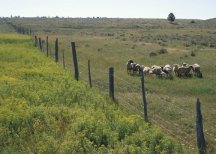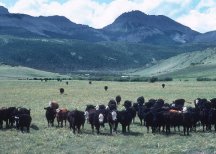Week 4
Roughages |
 |
 |
Instructions for listening to audio clips
- Download the QuickTime
Player to listen to the audio files.
- Read the QuickTime
Instructions for installation help.
- Download the RealPlayer to listen to the audio files
- Instructions are on the RealPlayer download page
Cultivated Pasture and Rangeland Forages
Text Transcript
Follow along with the audio...
- Cultivated or seeded pastures
- Forage species
- In general, grass-legume mixtures
- Provision of adequate moisture
- Management of irrigation
- Factors to consider
- Method and frequency of irrigation
- Amount of moisture per application
- Removal of excess moisture (i.e. drainage)
- Fertilization
- Higher fertility required for maximum yield and nutritional value
- Type and amount
- Dependent upon plant species and production objectives
- Three main nutrients: N, P, and K
- Grass-legume
- N promotes grass growth
- P promotes legume growth
- Minerals deficient in soils
- Grazing animals
- Maximize profitability of pasture with high yield and nutritional
value
- Graze high-producing animals
- Lactating and growing cattle and sheep
- Supplementation
- May be required to improve animal production
- Pastures in vegetative state high in CP
- Energy content low relative to CP
- Supplement with energy source to improve MCP synthesis and animal
production
- Rangelands
- Large, naturally vegetated land areas
- Figure 8.14 – Sheep on rangeland; rotation grazing system

- Figure 8.15 – Cattle on rangeland

- In general, relatively low densities of grasses, legumes, forbes,
and browse
- Native and introduced species
- Majority west of Mississippi River
- In west, majority owned and administered by U.S. government
- In general, compared to cultivated pastures
- Less productive – yield and nutritional value
- In part, due to properties of vegetation and rangeland system
- Forage species
- Topography
- Soil and environmental conditions
- Previous use of land
- More difficult to manage
- Multiple purpose
- Antinutritional factors more of a concern
- Specific factor varies
- Concentration of factor varies
- Soil and environmental conditions
- Forage manager
- Know: species, species’ antinutritional factors, and factors
influencing concentration
- Manage to reduce opportunity for toxicity
- Economic loss greater for loss in productivity versus death
- Management
- Forage, animal, and rangeland
- Factors include forage species, yield, nutritional value, and
season, stocking rate, distribution, supplementation, resource
improvement, etc.
- Animal selection
- Factors include economics, vegetation, water, topography, and
predators
- Common or dual use
- More than one species in grazing system
- Different preferences for forage species, portions of forage,
terrain, temperature, and distance from water
- Forage preferences vary with season and maturity
- Maximum forage utilization
- Cattle
- Prefer grasses and forage legumes
- Sheep and goats
- Consume more forbes and browse
- Extent of defoliation
- 50-50 rule
- Graze 50% of weight of forage and leave 50%
- Promotes future forage production
- Also applied to cultivated pastures
- Season of use
- Animal and future forage production
- Factors include vegetation, topography, and climate
- Classifications of season
- Improvement
- Indicators of degradation include decrease in favorable forage
species, an increase in unfavorable forage species, and an increase
in erosion
- Animal management practices
- Conservative stocking rates
- Appropriate seasonal use
- Proper animal distribution
- Methods to improve
- Rotation system
- Fencing
- Herding
- Additional water
- Location of supplements
- Controlling pests
- Trail building
- Additional practices include reseeding and brush and weed control
- Grazing systems
- Principles similar to cultivated pastures
- Continuous
- Most common
- Management via stocking rate and animal distribution
- Advantages
- More efficient on less productive ranges
- More practical for seasonal ranges
- Disadvantages
- Lower stocking rate
- Lower animal production per unit area
- Poorer animal distribution
- Less opportunity for range improvement
- Rotation
- In general, maximize forage and animal productivity
- Preservation of wildlife habitat and water resources
- Primary types
- Deferred rotation
- Season of grazing and resting periods for each pasture vary
year to year
- Figure 8.16 – Deferred rotation grazing system

- Short duration
- Frequent movement between small pastures
- Frequency dependent on forage availability
- More forage, more frequent movement
- Examples include rectangular and cell grazing
- Supplementation
- In general, required to fulfill nutrient requirements
- Type and level
- Depends on animal requirements and forage nutritional value
- Varies by season and year
- In general, include energy, protein, minerals (especially P), and vitamins (especially A)
- Energy
- Low forage availability
- Low forage digestibility
- Risk for nitrate toxicity high
- Low energy to protein ratio
- Daily
- Protein
- Provides protein and improves utilization of other nutrients
- Every other day or twice per week
- Macrominerals, microminerals, and vitamins with use of carrier
|



